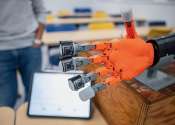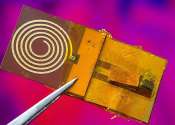Engineers develop breakthrough 'robot skin'
Smart, stretchable and highly sensitive, a new soft sensor developed by UBC and Honda researchers opens the door to a wide range of applications in robotics and prosthetics.
Oct 26, 2023
0
201
Robotics

Smart, stretchable and highly sensitive, a new soft sensor developed by UBC and Honda researchers opens the door to a wide range of applications in robotics and prosthetics.
Oct 26, 2023
0
201
Engineering

Engineers at the University of California San Diego have developed electronic "stickers" that measure the force exerted by one object upon another. The force stickers are wireless, run without batteries and fit in tight spaces. ...
Oct 10, 2023
0
114
Engineering

Human skin is amazing. It senses temperature, pressure, and texture. It's able to stretch and spring back, time and again. And it provides a barrier between the body and external threats—bacteria, viruses, toxins, ultraviolet ...
Jun 1, 2023
0
58
Electronics & Semiconductors

Virtual and augmented reality (VR and AR), often combined under the term 'extended reality (XR)', are increasingly losing their niche status and entering the mass market. Think of the metaverse, gaming, applications in industry ...
Mar 9, 2023
0
9
Engineering

Sensing a hug from each other via the internet may be a possibility in the near future. A research team led by City University of Hong Kong (CityU) recently developed a wireless, soft e-skin that can both detect and deliver ...
Feb 23, 2023
0
50
Robotics

A team of researchers at the Chinese Academy of Sciences, has developed an artificial finger that was able to identify certain surface materials with 90% accuracy. In their paper published in the journal Science Advances, ...
Robotics

More than a decade ago, Ted Adelson set out to create tactile sensors for robots that would give them a sense of touch. The result? A handheld imaging system powerful enough to visualize the raised print on a dollar bill. ...
Jul 27, 2022
0
39
Robotics

We tend to take our sense of touch for granted in everyday settings, but it is vital for our ability to interact with our surroundings. Imagine reaching into the fridge to grab an egg for breakfast. As your fingers touch ...
Jun 2, 2022
0
222
Hardware

The sense of touch is important for human development, interpersonal communication, and social attachment. For situations where one is separated by distance affective haptic devices (AHDs) can be used as a new form of sense ...
May 13, 2022
1
19
Robotics

Machines can beat the world's best chess player, but they cannot handle a chess piece as well as an infant. This lack of robot dexterity is partly because artificial grippers lack the fine tactile sense of the human fingertip, ...
Apr 5, 2022
0
159
The somatosensory system is a diverse sensory system comprising the receptors and processing centres to produce the sensory modalities such as touch, temperature, proprioception (body position), and nociception (pain). The sensory receptors cover the skin and epithelia, skeletal muscles, bones and joints, internal organs, and the cardiovascular system. While touch is considered one of the five traditional senses, the impression of touch is formed from several modalities; In medicine, the colloquial term touch is usually replaced with somatic senses to better reflect the variety of mechanisms involved.
The system reacts to diverse stimuli using different receptors: thermoreceptors, mechanoreceptors and chemoreceptors. Transmission of information from the receptors passes via sensory nerves through tracts in the spinal cord and into the brain. Processing primarily occurs in the primary somatosensory area in the parietal lobe of the cerebral cortex.
At its simplest, the system works when a sensory neuron is triggered by a specific stimulus such as heat; this neuron passes to an area in the brain uniquely attributed to that area on the body—this allows the processed stimulus to be felt at the correct location. The mapping of the body surfaces in the brain is called a homunculus and is essential in the creation of a body image.
This text uses material from Wikipedia, licensed under CC BY-SA